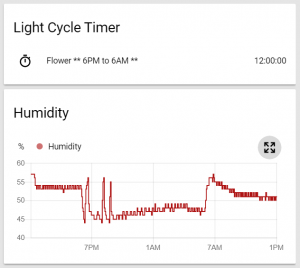Time to focus on HUMIDITY!

Humidity
Needed Monitors:
(Good) Hygrometer
(Better) Monitor with switched fan Controller
(Best) Dehumidifier/Humidifier and a My Smart Grow system
(Free) Web tool: http://www.dpcalc.org/
The Humidity of the environment is represented by Relative Humidity %. A higher percentage means that the air-water mixture is more humid. This is variable by different temperatures and pressure of the air. It requires less water vapour to attain high relative humidity at low temperatures and more water vapour is required to attain high relative humidity in warm or hot air and.
The dew point is the temperature and humidity level in which water will transpire from the air (and show up as drops of water on your plant leaves and grow area walls/equipment). You need to avoid moisture levels near or at the dew point to avoid mold and potential problems with equipment due to rust. Check your environmental conditions against the dew point calculator to be sure you will not run into problems during flowering as the density of the flowers will add to the mold possibility if the conditions are not right. http://www.dpcalc.org/
While this may be confusing, all you need to know is relatively simple: Your goal is to keep moisture in the environment available for the plant to not over or under transpire, and to be sure keep it the RH in and around the plant mass low enough as to not allow fungus or molds to form which are toxic when consumed and can destroy gardens overnight. For the purpose of cannabis, you never want the plant below 70 degrees at the coolest and keep the relative humidity below 65% and above 45% to be safe. Keep in mind, the later in the flower period you are, the lower you want the RH to keep your flowers free from germinating mold or mildew. Never spray a bud with water or product once a flower has formed. We personally never spray any plants unless they are a clone needing moisture.
You have to balance a good growing environment for the plant vs the good growing environment for funguses microbes and molds which are very close to one another but not entirely. We obviously want to error on the side of the plant. There are nutrients you can buy to keep your plants pest free naturally without sprays. Know that the more dense and larger the bud structure ( Indica) the higher chance of mold due to the lesser airflow and tightly stacked leaves. This is one reason why sativa dominant plants to thrive in their native moist environments such as Thailand and Indonesia. Keeping a fan blowing across the canopy can help keep the spores from germinating and ruining the crop. It helps tremendously to keep a clean environment and to not bring in excess outside spores into your grow space. While mold spores are completely unavoidable in any growing environment, it is avoidable to allow them a space to live or thrive.
During seedling stage stay at 65-75% RH low to no nutrient ppm: keep a high humidity but allow some airflow in your area to keep mold from forming. You can make your own “microenvironment” with a simple plastic cover and monitor the interior of it to stay between 65-75% RH. At this stage they can survive without nutrients off of stored supplies. You should only add nutrients after the first set of serrated leaves appear and only if not vibrant green in appearance. If such a case add ¼ strength or 100-150 ppm max.
The next stage called the Vegetative period stay at 65-55RH and give plants 150-300 ppm of nutrients. After the first set of bladed leafs appear you will want to lower the RH to 60-50%. Sometimes this can be achieved by simple venting out of the space where the air is then replaced from air in the other rooms as most occupied spaces keep a RH of +/-50%. This simple solution of passive internal venting can be used if only a few plants are present. As the plant count or vegetation goes up, so does the transpiration rate which adds more moisture to the air, and makes controlling relative humidity with passive ventilation harder to achieve without the use of an electric dehumidifier. If you have the money to spend on the unit and the electricity to run it, a dehumidifier will allow you to grow more plants in a smaller space and provide automatically controlled optimal RH% although they do create heat which must also be controlled. Depending on your conditions a portable AC unit is handy and can both cool and dehumidify.
Flowering period requires 12/12 light and dark with no more than 65%with 50 percent RH optimal. Temperatures never below 70f or above 82f strain depending. Flowering nutrients at or above 300-500 strain depending.
Once you <initiate flowering/> by changing the lighting schedule to 12 hours of “light on” and <completely depriving/> the plant of light for 12hr your plants will need the RH lowered as the flowering and density grows. Keeping 60-50% RH during early <flowering/> and lowering to 45-50% for the <mid to finish/> Every strain and plant is different and can be more or less resilient in a mold prone environment. Luckily there are products to make your plant more resilient to mold or mildew problems such as Silica based Pro Tec from Dyna Gro. They allow the plant to build solid cell walls so the fungus cannot root. It also acts in the same way against mites and other parasites. It is an armor building supplement for your leaf structure! Silica is part of all soil bases and when missing from a hydroponic regimen side by side structure and growth as well as water retention/resilience to drought is drastically increased when utilized properly. It can also be used as a PH Up when diluted with water.
Tags: growing, indoor, Temperature
